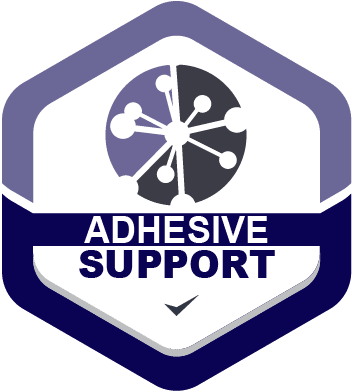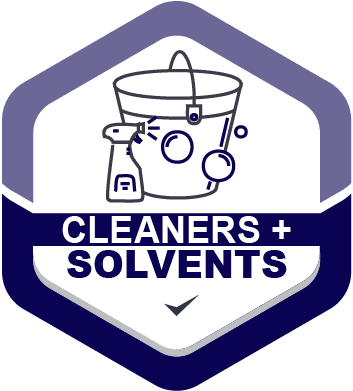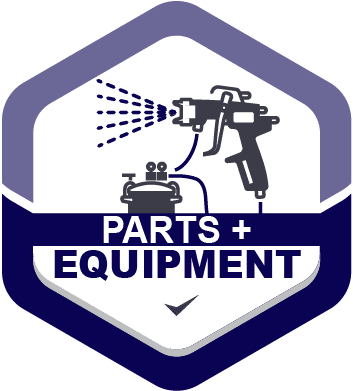ADHESIVE
TROUBLESHOOTING
ADHESIVE CHALLENGES GUIDE
HOT MELT
WATERBASED
DRY BLEND ADHESIVE
WOODWORKING ADHESIVE
FINISHED CONSTRUCTION
LIQUID CASE AND CARTON
HOT MELT TROUBLESHOOTING:
POOR ADHESION
HOT MELT TROUBLESHOOTING
POOR ADHESION
There are 4 reasons you might be experiencing poor adhesion with your hot melt.
- If you notice that the adhesive is mostly on one surface it is likely the result of a short 'open time' or a very difficult to bond surface. Try increasing the temperature of the adhesive in the interim and contact your adhesive provider.
- If the adhesive is on both surfaces but is showing "legs" the bond of the adhesive may have been disturbed while still in a semi-molten state. You should check the compression, lower your adhesive temperature or switch to a faster setting adhesive.
- If the surface of the adhesive is glossy in appearance or no fiber tear is present, there may have been little to no contact of the surfaces being adhered. Try adjusting the pressure to keep the glued surfaces together while the hot melt cools.
- If there is an easy separation of the bond and/or no fiber tear, an improper adhesive may have been selected. We recommend trying a more suitable product (which we’re happy to produce).
ADHESIVE CHARRING
HOT MELT TROUBLESHOOTING
ADHESIVE CHARRING
If you are experiencing charring of the adhesive, you should consider these three problems.
- The temperature in the tank may be too high, in which case you should lower the temperature in the tank.
- The adhesive may be charring on the side walls of the tank. The best solution for this issue is to ensure the tank is kept filled.
- Air may be oxidizing the adhesive. To prevent this, be sure to keep your tank covered.
ADHESIVE GELLING
HOT MELT TROUBLESHOOTING
ADHESIVE GELLING
There are three possibilities as to why you may be experiencing gelling of the adhesive.
- You may be overheating the adhesive. We suggest draining and flushing the system and lowering the temperature.
- You may be mixing incompatible adhesives. In this situation you should check with your Walmark representative for advice on compatible adhesives.
- If you’ve repeated usage, the hot melt may be unstable. Please check with your Walmark representative.
ADHESIVE STRINGING
HOT MELT TROUBLESHOOTING
ADHESIVE STRINGING
In the instance that your adhesive is stringing, you should consider these four troubleshooting options.
- You may be running the temperature too low. Raise the temperature, however, be careful not to raise the temperature too high or the heat stability may be affected.
- The stock temperature may be too low. Try prewarming the stock.
- You may be experiencing poor timing or misalignment of the carton flap to the applicator roll. This will require a machine adjustment.
- The nozzle may have been poorly shutoff. Try cleaning and repairing the nozzle shutoff.
ADHESIVE NOT FLOWING EVENLY THROUGH ALL NOZZLES
HOT MELT TROUBLESHOOTING
ADHESIVE NOT FLOWING EVENLY THROUGH ALL NOZZLES
If the adhesive is not flowing evenly from all nozzles it could be a result of these two problems.
- The nozzles may be clogged and require cleaning or repair.
- The remote nozzle in the multitude nozzle set-up may be affected by a pressure drop. In this case you should increase the temperature or pressure slightly. Put larger orifice openings on remote nozzles. The melt down capacity of the unit may be inadequate for the demand, therefore you should raise the temperature or add an auxiliary pre-melter.
FUMING OR SMOKING
HOT MELT TROUBLESHOOTING
FUMING OR SMOKING
There are two reasons you might be experience fuming or smoking of your adhesive.
- Poor heat control. Use a calibrated thermometer and reset the thermostat.
- The adhesive may have poor heat stability. Try reducing the temperature to the minimum required for a good bond. Cover the reservoirs or pre-melters whenever possible and open pots almost always for smoke. Use the suction fan over the pre-melter or reservoir and exhaust the fumes to the outside.
WATERBASED TROUBLESHOOTING:
POOR PENETRATION
WATERBASED TROUBLESHOOTING
POOR PENETRATION
There are two probable causes as to why you might be experiencing poor penetration.
- You may be using an insufficient amount of adhesive. Increase the amount of adhesive being applied.
- It may be because of the porosity or sizing of the substrate. This could signify an improper adhesive. Please contact your Walmark sales representative.
ADHESIVE SETTING TOO QUICKLY
HOT MELT TROUBLESHOOTING
ADHESIVE SETTING TOO QUICKLY
If you're noticing that the adhesive is setting too quickly, you should consider these three probable causes.
- You may not be using enough adhesive. Increase the amount of adhesive being applied.
- The open time may be too long, in which case you should increase the machine speed.
- The ambient temperature may be too hot. Remedy the temperature if possible or increase the amount of adhesive you are using.
ADHESIVE SETTING TOO SLOW
WATERBASED TROUBLESHOOTING
WATERBASED TROUBLESHOOTING
ADHESIVE SETTING TOO SLOW
In the case that your adhesive is setting too slow, these three problems could be to blame.
- You are using too much adhesive. We recommend reducing the amount of adhesive or increasing the compression.
- The humidity is too high. In order to compensate for this issue, you should reduce the amount of adhesive being applied.
- The ambient temperature may be too cold. Attempt to maintain room temperature for the adhesive and substrates.
POOR MATCHING
WATERBASED TROUBLESHOOTING
WATERBASED TROUBLESHOOTING
POOR MATCHING
If you are experiencing poor matching of your adhesive, try checking into these three possible causes.
- The adhesive may be too cold. Try raising the temperature of the adhesive or the environment.
- The adhesive may be contaminated. To prevent contamination, you should ensure the cleanliness of the reservoir and nozzles etc.
- There could be some adhesive build-up in the equipment. Always check and clean all the equipment
DRY BLEND ADHESIVE TROUBLESHOOTING:
POOR ADHESION
DRY BLEND ADHESIVE TROUBLESHOOTING
POOR ADHESION
Delaminating, dog-earing etc..
- Check equipment- ensure enough adhesive is being applied.
- Check paper- porosity of paper will affect how easily adhesive is absorbed If absorbed to quickly, bond can be poor.
- Equipment speed- run speed is too fast for your adhesive.
- Check adhesive- has any settling occurred? Mix properly. Check solids and viscosity.
POOR COOK
DRY BLEND ADHESIVE TROUBLESHOOTING
POOR COOK
- Check temperature of the kettle.
- Ensure you are cooking long enough to ensure a smooth adhesive consistency (no lumps).
- If cooking with steam, check viscosity to ensure no excess water has been added to batch.
SERVICE IS OUR PRIMARY PRODUCT.
Have a difficult substrate? Not sure what you need? Glue is what we do!Call us at 800-682-0479 or reach out for free technical assistance.Walmark has your back with adhesives for production to end of line packaging.Ask your Walmark Rep how you can turn lead time into transit time with our dedicated stock program.






